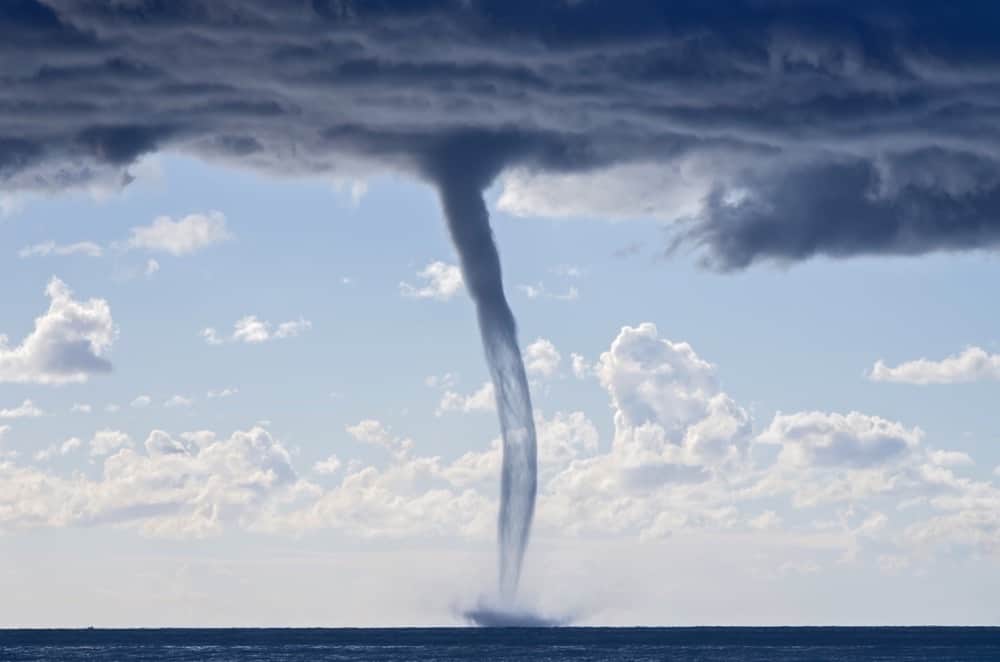By Ann Eichenmuller
The headboat was anchored in the Newport News Middle Ground, eager fishermen with poles out,
the first mate chumming off the stern. He and the captain had their eyes on the northwest sky, focusing
on a build-up of heavy, dark clouds. They watched in horror as a thin funnel dipped down and touched the surface, then began to twist its way toward them.
The captain, normally a gregarious soul, ran to the helm without saying a word. He turned over the engine and slammed the boat into gear as the mate scrambled to the bow. The young mate got his hands on the anchor line and pulled with all his might as the boat catapulted forward. The anchor came loose, and as he wrestled it aboard, he turned to see the captain standing white-faced, hatchet in hand—ready, if need be, to cut the line.
That first mate was my husband, and he realized then that any weather phenomenon capable of shaking a seasoned headboat captain is one worth taking seriously. It’s no wonder waterspouts are the stuff of legends. Decade ago, sightings were considered a rarity, but today Facebook and Instagram are flooded with photos of water-borne twisters on the Chesapeake. What has changed? According to Channel 6 Richmond’s chief meteorologist Zach Daniel, it’s not necessarily the weather.
“Twenty years ago, there were very few cell phones. If you were out on a boat and you saw a waterspout, maybe you’d come home and call a friend. That’s as far as it would go. Now everyone carries a smartphone with a camera all the time. Nothing escapes being documented.”
That doesn’t mean it’s good idea to chase waterspouts to get the perfect shot to share. Waterspouts may be photogenic, but they are also dangerous.
“We’re often talking about tornadic activity associated with strong thunderstorms,” Daniel explains. “These supercells can produce waterspouts, or they can form tornadoes over land that then move across the water without losing much of their strength.”
A particularly devastating example of the latter is the 2016 EF-3 tornado that ripped through Essex County in Virginia, then crossed a mile-and-a-half-wide section of the Rappahannock River before moving ashore on the Northern Neck, leaving widespread damage in its wake. And though storm-created waterspouts that form over water tend to be weaker, they are often accompanied by high winds, rough seas, rain, lightning, and even hail. They can travel at up to 80 miles per hour, and have a diameter anywhere from a foot to the size of a football field.
If that isn’t enough, Daniel says it is even possible for waterspouts to form without any storm at all. “We call those fair-weather waterspouts, akin to a ‘dust devil’ or a ‘leafnado.’ Anytime you have cooler air above a warm, humid surface, you’ve got an atmosphere that we call buoyant. Situations like this can easily produce waterspouts in quiet conditions.”
Fair-weather waterspouts tend to be short-lived, move very little, and fall apart when they touch land—but that doesn’t mean they couldn’t capsize a small boat or cause damage to a larger vessel. That is why the National Weather Service warns boaters to take precautions whenever encountering a waterspout, regardless of origin:
- If you spot a waterspout, seek safe harbor immediately.
- Avoid the waterspout by traveling at right angles to its apparent direction of movement.
- If a collision is likely, take down sails, secure loose items, close hatches, and go below deck if possible.
- Under no circumstances should a boater try to navigate through a waterspout.
And even though legend has it that firing a cannon into a waterspout’s path will break it up, this myth is unsubstantiated, so don’t fire your flare gun or launch your deck chairs toward one.
In terms of waterspout myths, several local watermen say they have heard tell of it “raining fish” that were suctioned up with the water in a waterspout. Daniel points out that the funnel you see is not “sucked-up” seawater, but rather a swirling mist of condensed water vapor. However, he agrees that a tornado over water does have enough suction to carry objects—including fish. According to New York meteorologist Bill Evans in his book It’s Raining Fish and Spiders, all sorts of creatures have in fact been reported raining down during tornadic activity, including snakes, worms, and crabs, but fish and frogs are the most common. Worldwide, he writes, such events are reported about 40 times a year.
So next time you’re boating and see a waterspout, keep your distance—and just to be safe, you might want to cover your head.
The first in Zach Daniel’s series of children’s weather books, Walter and the Terrible Twister, was released this month.




